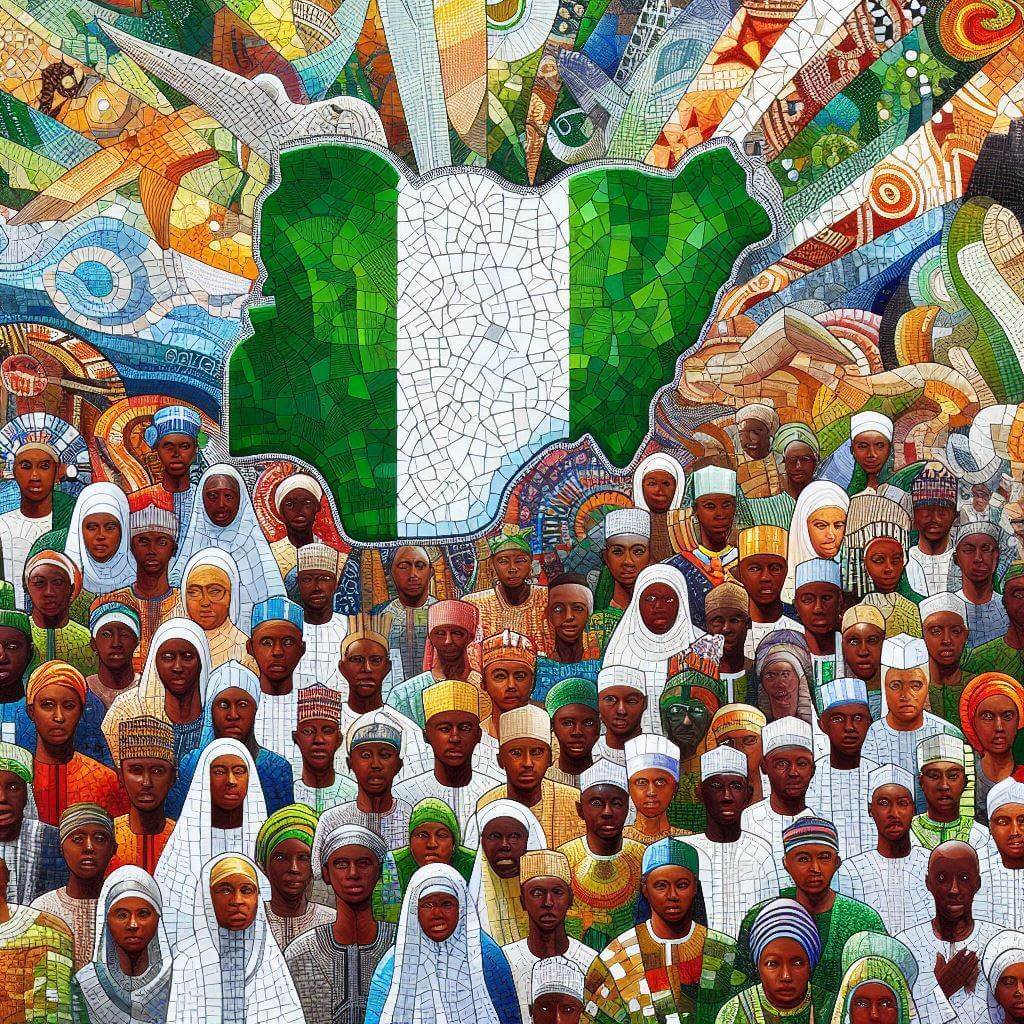The flag of Nigeria consists of three equal vertical stripes of green, white, and green. This simple yet striking design represents the country's rich natural resources, diverse cultural heritage, and aspirations for peace and unity, making it a powerful symbol of Nigerian identity and nationhood.
Nigeria information
| National Flag Day | October 1 |
| Sovereign state | Yes |
| Official name | Federal Republic of Nigeria |
| Capital | Abuja |
| Population | 202,915,907 |
| Area | 923,768 km² |
| Currency | Nigerian naira (NGN) |
| Language | English (official), Hausa, Yoruba, Igbo, Fulani |
| Continent | Africa |
| Region | West Africa |
| Subregion | — |
| Borders | Benin, Chad, Cameroon, Niger |
| Timezone | West Africa Time (WAT) UTC+1 |
| Calling code | +234 |
| Top-level domain | .ng |
History of the Nigerian Flag
 The Nigerian flag was officially adopted on October 1, 1960, coinciding with Nigeria's independence from British colonial rule. The design was created by Michael Taiwo Akinkunmi, a Nigerian student studying in London, who won a competition to design the new nation's flag in 1959. Akinkunmi's original design included a red radiating sun on the white stripe, which was later removed for simplicity. The flag has remained unchanged since its adoption, symbolizing continuity and stability in Nigeria's national identity.
The Nigerian flag was officially adopted on October 1, 1960, coinciding with Nigeria's independence from British colonial rule. The design was created by Michael Taiwo Akinkunmi, a Nigerian student studying in London, who won a competition to design the new nation's flag in 1959. Akinkunmi's original design included a red radiating sun on the white stripe, which was later removed for simplicity. The flag has remained unchanged since its adoption, symbolizing continuity and stability in Nigeria's national identity.
Symbolism and Design of the Nigerian Flag
The Nigerian flag's design is both simple and deeply symbolic:
- The green stripes on either side represent Nigeria's natural wealth, particularly its lush forests, abundant agriculture, and rich oil reserves.
- The white stripe in the center symbolizes peace and unity. It represents the desire for harmony among Nigeria's diverse ethnic groups and religions.
- The vertical orientation of the stripes is distinctive, differentiating Nigeria's flag from many other tricolor flags and emphasizing the country's strength and forward momentum.
Usage and Significance of the Nigerian Flag
 The Nigerian flag is a ubiquitous symbol of national identity and pride. It is prominently displayed on government buildings, schools, and during national celebrations such as Independence Day on October 1. The flag plays a crucial role in fostering a sense of unity among Nigeria's diverse population of over 200 million people, comprising more than 250 ethnic groups. In international contexts, the flag represents Nigeria at diplomatic events, United Nations gatherings, and sporting competitions, symbolizing the country's sovereignty and its significant role in African and global affairs.
The Nigerian flag is a ubiquitous symbol of national identity and pride. It is prominently displayed on government buildings, schools, and during national celebrations such as Independence Day on October 1. The flag plays a crucial role in fostering a sense of unity among Nigeria's diverse population of over 200 million people, comprising more than 250 ethnic groups. In international contexts, the flag represents Nigeria at diplomatic events, United Nations gatherings, and sporting competitions, symbolizing the country's sovereignty and its significant role in African and global affairs.
Interesting Facts About the Nigerian Flag
- The designer of the Nigerian flag, Michael Taiwo Akinkunmi, was only 23 years old when he created the winning design in 1959.
- Nigeria's flag is one of the few national flags that use only two colors (excluding white), making it highly recognizable and distinctive.
- The green color in the flag is often associated with Nigeria's nickname, "The Giant of Africa", referring to its large population and economic influence on the continent.
- The flag's design has inspired various national symbols and branding efforts, with the green-white-green color scheme often used in Nigerian sports uniforms and official logos.
- Despite Nigeria's complex political history and regional tensions, the flag has remained a unifying symbol, unchanged since independence.